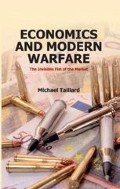Abstract
Besides altering the availability of currency, “counterfeiting” is an effective way that has been used a great number of times throughout history to discredit local currencies, although this is no longer as easy a task as it once was. The prevalence of counterfeiting throughout history has led many nations to take a number of anticounter-feiting measures to protect against such strategies. The result is not an end to counterfeiting but, rather, a limited number of people skilled in the trade being secretly employed by military and intelligence agencies either for purposes of creating this false-currency or, more commonly, detecting counterfeits and tracking perpetrators. Counterfeiting, when done successfully, is such an effective strategy that it can completely discredit entire governments, particularly when distributed through targeted channels to maximize their effectiveness. As a result, nations go to great lengths to combat counterfeit currencies, including some of the following:
-
1
Serial numbers are logged and monitored to identify and track bills while confirming the existence of counterfeit bills and expediently finding them.
-
2
The addition of a portrait is extremely common, and has been so for centuries, among many world currencies. These are difficult to replicate and added detail results in increased difficulty.
-
3
Printed textures are included in the backgrounds of the images on both sides of the bill using extremely fine lines.
-
4
An offset watermark identical to the portrait and printed on both sides of the bill becomes visible only when held up to the light.
-
5
Layered seals are printed over or under other text but still remain visible giving the appearance of translucency.
-
6
Money is often printed on various types of special “paper,” made by incorporating materials such as wool, cotton, or synthetic polymers.
-
7
Color-shifting ink used in the one corner of bills that appears of one color when looked at directly and appears to change colors when looked at from an angle.
-
8
Microprinting used to create the drawings and include text in various spots are extremely detailed, additional textures are also added, and are extremely difficult to replicate clearly.
-
9
Federal Reserve indicators show exactly which bank issued the currency to assist with tracking, alongside the serial numbers.
-
10
Within the paper lies an ultraviolet-reactive security thread that can be seen when held up to the light and will glow under a black light.
-
11
Low-vision, machine readable numerals at one corner of the bills are designed to be read by machines created to be used by blind individuals to help them cope with the challenges of identifying currency denominations without the help of others.
Preview
Unable to display preview. Download preview PDF.
Copyright information
© 2012 Michael Taillard
About this chapter
Cite this chapter
Taillard, M. (2012). Counterfeiting. In: Economics and Modern Warfare. Palgrave Macmillan, New York. https://doi.org/10.1057/9781137282255_18
Download citation
DOI: https://doi.org/10.1057/9781137282255_18
Publisher Name: Palgrave Macmillan, New York
Print ISBN: 978-1-349-44140-2
Online ISBN: 978-1-137-28225-5
eBook Packages: Palgrave Economics & Finance CollectionEconomics and Finance (R0)

